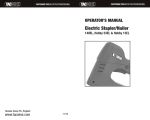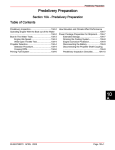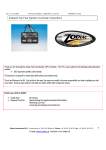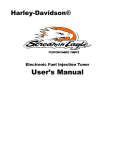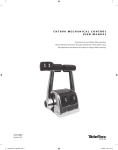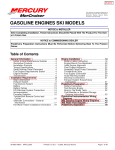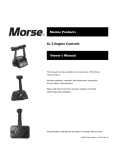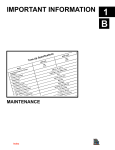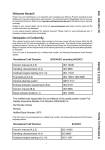Download DATE: 5/8/80 A. STEERING LINK ROD - 1980 Merc 40
Transcript
\ - DATE: 5/8/80 CIRCULATE TO: SERVICE MANAGER PARTS MANAGER MECHANICS A. B. C. D. Steering Link Rod - 1980 Merc 40 thru l4OEL Remote Control Repair New Style Hydraulic Pump - Proper Filling and Vent Procedure RPM Loss A. STEERING LINK ROD - 1980 Merc 40 thru 140EL (Attach Service Bulletin Sticker on P . 7A-1 in Your C-90-86134 Service Manual.) Should it become necessary to replace the steering link rod on a 1980 model Merc 40 thru Merc 14OEL, Ride-Guide Attaching Kit C-79278A1 must be ordered. Installation instructions are included in the kit. B. REMOTE CONTROL REPAIR (Attach Service Bulletin Sticker on Sec. 8 B Index Page in Your C-90-74041 Service Manual.) Some dealers have been repairing worn electric remote controls by ordering Part No. A-45955A6 manual control and re-installing the electric harness. This control (A-45955A6) now has been superseded to Part No. A-87728A20 which is not compatible with older electric models. It is recommended that electric remote controls be repaired with parts available thru service stock or order MerCruiser remote control A-45958A5. - C. NEW STYLE HYDRAULIC PUMP Proper Filling and Vent Procedure (Attach Service Bulletin Sticker on P. 6-1 in Your C-90-86133 Service Manual.) T h e initial filling and venting of the new style hydraulic pump (as used on V-6 outboards) is very important to the operation of the trim and tilt system. Carefully follow the instructions (following) or those in the “engine mounting instructions” that accompany the outboard. IMPORTANT: DO NOT remove “Down” port plug (Figure 1) from pump while filling trim system. 1. Check fluid level in pump as follows: a. Place engine in full “down” position. b. Remove “Fill-Vent” screw (Figure 1) and wipe off dipstick with a clean, lint-free cloth. c. Insert dipstick back into reservoir. d. Pull dipstick from reservoir and check fluid level on stick (top line on dipstick is “Full”; bottom line is “Add”). -1- f a b - “Down” Port Hose - Hose Fitting Adaptor Figure 2. Connecting “Down” Port Hose to Trim Pump a - “Fill-Vent’’ Screw b - Dipstick (Top Line on Dipstick Is “Full”; Bottom Line is “Add”) \A6 c - “Up” Port Hose d - “Down” Port Plug e - Manual Tilt Knob Figure 1. Hydraulic Trim Pump “Up” Hose Connected 12328 2. Remove (and retain) trim adjustment bolt from transom bracket. This will allow engine to be trimmed to the full “in” position (necessary only when filling hydraulic system). 3. Make sure that manual tilt knob (Figure 1) is turned full “in” (clockwise, finger-tight only). 4. Remove “Up” port plug from hydraulic pump and connect “Up” port hydraulic hose (Figure 1) to pump. Be careful not to cross-thread or over-tighten hose fitting. 5. Remove shipping cap from end of “Down” port hydraulic hose. NOTE: “Down” port plug in pump is removed after filling hydraulic system. 6. Remove “Fill-Vent” screw (Figure 1) and fill pump reservoir to “Full” line on dipstick. Use SAE 1OW-40 “SE” automotive oil. 7. Depress “Trailer” tilt button on remote control. Engine will trim u p part-way and stop (lack of fluid). At this time, refill pump reservoir to “Add” line (not the “Full” line) on dipstick. Continue this procedure until engine tilts all-the-way up. IMPORTANT: DO NOT over-fill reservoir during this procedure, or oil will overflow the reservoir when tilting down. 8. Remove “Down” port plug from hydraulic pump and thread hose fitting adaptor (Figure 2) into pump. Connect “Down” port hydraulic hose to hose fitting adaptor and tilt engine down by depressing the “In” button on the remote control. NOTE: I f the pump sounds like it is running free, and the engine does not trim in, add more oil to the Pump. IMPORTANT: The initial air in the system will have caused the oil in the pump to foam, giving a false reading. Fluid level in the pump should be checked after the system has “set” for approximately 20 minutes. 9. Bleed air from hydraulic trim system b y operating trim system 3 or 4 times thru entire trailering range, while maintaining fluid in the pump reservoir to the “Full” line on the dipstick. Check fluid level in pump when engine is in full “down” position (see “Important”, immediately preceding). Reinstall “Fill-\’ent” screw. Turn screw all-the-way in and back out 1-1/2 turns (this vents the reservoir). -2- IMPORTANT: “Fill-Vent” screw (Figure 3) must be backed out 1-1/2turns to vent the reservoir. 10. Check entire trim system for leaks. 11. Reinstall trim adjustment bolt (removed in Step 2 ) into transom bracket. If necessary, refer to the section o n “Trim Angle Adjustments” in the “V-6 Model Outboards Eng i n e Mounting In s t r u c t i o n s” (C-90-88933). a - “Fill-Vent’’ (Turn Screw All-the-Way In and Back Out 1-1/2 Turns; This Vents the Reservoir) Figure 3. Both Hoses Connected on Hydraulic Trim Pump D. RPM LOSS Occasionally, the Mercury Marine Service Department hears customer complaints of top RPM loss. This 300-500 RPM loss can occur suddenly and for no apparent reason. Listed below are several causes of this problem. 1. Temperature and Humidity Summer conditions of high temperature, low barometric pressure and high humidity all combine to reduce the engine power. This, in turn, is reflected in decreased boat speeds -- as much as 2 or 3 miles-per-hour in some cases. Nothing but the coming of cool, dry weather will regain this speed for the boater. 2. Over-Propping For boaters to realize optimum engine performance under changing weather conditions, it is essential that the engine be propped to allow it to operate at or near the top end of the recommended maximum RPM range at wide-open-throttle. Not only does this allow the engine to develop full power, but equally important is the fact that the engine also will be operating in an RPM range that discourages damaging detonation. This, of course, enhances overall reliability and durability of the engine. 3. Changes in Boat Condition Scum, moss and many other forms of marine growth can develop rapidly on a boat bottom. This can be a definite hindrance to boat performance. 4. Tachometer Incorrect Many times, hours of labor are spent in troubleshooting a n outboard only to find that the tachometer is not functioning properly. If RPM loss occurs, cross-reference the tachometer with the shop tachometer. 5. Use Quicksilver Engine Cleaner Quicksilver Engine Cleaner (C-92-86146) is a blend of chemicals designed to purge powerrobbing deposits that accumulate in gasoline engines. It eliminates costly dismantling of the engine to remove carbon deposits that are caused by certain types of‘ gasolines. Heavy carbon deposits in combustion chambers result in spark plug burning, pre-ignition and reduction of RPM. -3-



